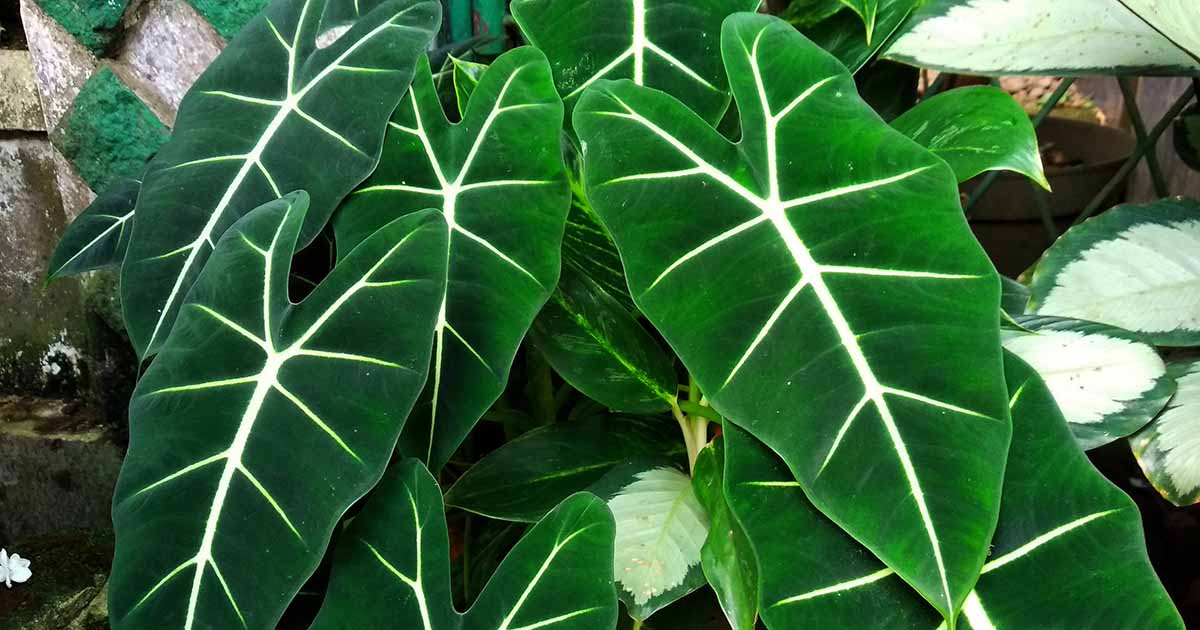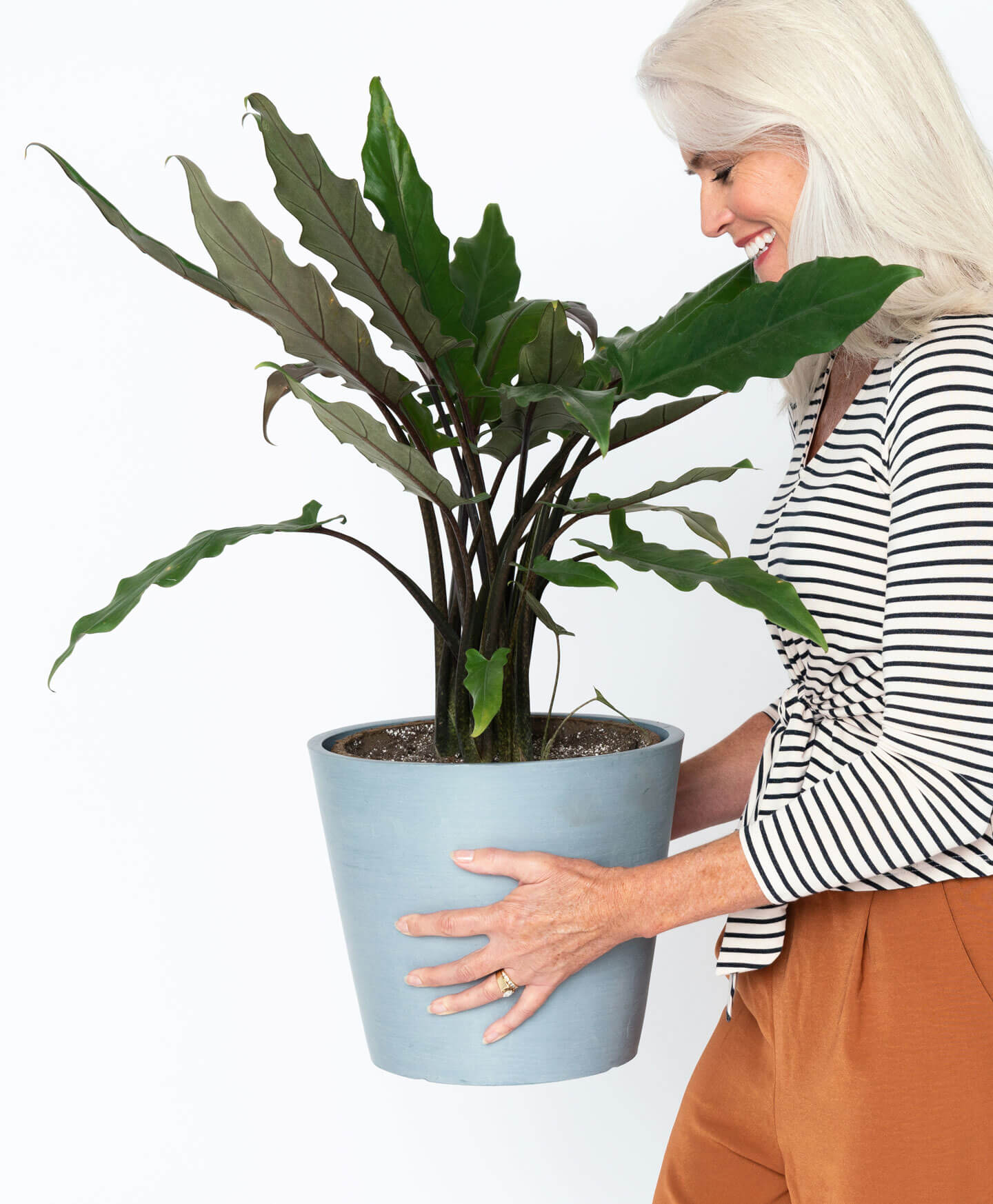With their impressively large, tropical foliage, alocasia are gaining popularity as striking houseplants But caring for these jungle beauties takes some specific growing conditions to keep them happy and healthy indoors.
Follow this comprehensive alocasia plant care guide to master the art of growing vibrant containers of elephant’s ear,
Alocasia Plant Care Basics
Alocasia are native to the hot, humid jungles of Asia and Australia. To recreate their preferred environment as houseplants:
-
Light – Bright indirect light is ideal. Some direct sun is tolerated. Low light causes sparse growth.
-
Temperature – Warm temperatures between 65-80 ̊F are needed. Keep away from drafty areas.
-
Humidity – High humidity of 60% or above is a must. Mist leaves or use a pebble tray.
-
Water – Keep soil consistently moist but not soggy. Reduce watering in winter.
-
Soil – Use a well-draining potting mix. Alocasia hate wet feet.
-
Fertilizer – Feed every 2-4 weeks in the growing season with a balanced liquid fertilizer.
Choosing the Best Alocasia for You
With over 70 species, there is an alocasia for every taste! Some popular varieties include:
-
Alocasia zebrina – Stunning tiger-like zebra stripes on stems. Finicky.
-
Alocasia amazonica – Compact hybrid with glossy leaves and contrasting veins.
-
Alocasia reginula – Deep green or black foliage with white veining.
-
Alocasia macrorrhiza – Very large mature leaves around 3 feet long.
-
Alocasia odora – Unusual hooded spathe flowers with unique fragrance.
Providing Perfect Growing Conditions
Alocasia are divas when it comes to their care requirements. Here’s how to keep them happy:
Give Bright, Indirect Light
Alocasia leaves will scorch if light is too intense. Filtered light from an east or west window is ideal. Rotate the plants to prevent lopsided growth toward the light source.
Increase Humidity
Use a humidifier, pebble tray, or frequent misting to keep the humidity around your alocasia above 60 percent.
Water Thoroughly
Allow the top couple inches of soil to dry out then water deeply until it runs from the drainage holes. Never let them sit in standing water.
Feed Regularly
Every 2-4 weeks in the growing season, feed with a balanced liquid fertilizer like 20-20-20 diluted to half strength. Reduce feeding in winter.
Keep Temperatures Warm
Alocasia prefer temperatures between 65-80 ̊F and will suffer below 60 ̊F. Keep away from drafty windows, vents, and air currents.
Give Acidic Soil
Alocasia like slightly acidic soil in the 5.5-6.5 pH range. Most basic potting soils fit the bill perfectly.
Repotting Alocasia
This fast growing plant likely needs repotting every 1-2 years in the spring. Go up just 1-2 inches to prevent overly large pots.
Propagating Alocasia
Propagate overcrowded plants by division in early spring. Gently divide rhizome root masses and pot up sections in small pots.
Troubleshooting Common Alocasia Problems
Yellow leaves – Usually caused by over or under watering. Keep soil evenly moist.
Sparse leaves – Not enough light. Move to a brighter spot or supplement with a grow light.
Brown leaf tips – Low humidity. Increase humidity level around the plant.
Drooping leaves – Overwatering or underwatering. Adjust watering practices.
Pale leaves – Needs more fertilizer. Feed every 2-4 weeks in the growing season.
Leggy growth – Insufficient light. Rotate plant or move to brighter area.
Displaying Alocasia
The large, geometric leaves of alocasia pair perfectly with modern decor. Here are some tips:
-
Let them take center stage in minimalist rooms as a bold focal point.
-
Complement midcentury, contemporary, or modern spaces.
-
Mix varieties for a lush, jungle vibe.
-
Place near other tropical beauties like ferns and begonias.
-
Repeat in multiples for dramatic impact.
Toxicity Caution
All parts of the alocasia plant are toxic if ingested, so keep away from pets and children. Wash hands after handling.
Enjoy These Tropical Treasures
With their show-stopping foliage, alocasia are the supermodels of the plant world. By providing warm temperatures, indirect light, high humidity, and frequent watering, your alocasia will thrive and add dynamic texture to your indoor jungle. Follow this care guide for growing success!

Alocasia Purple SwordLIGHT
Your Alocasia Purple Sword will thrive in bright, indirect light. Never allow this plant to stand in the direct sunlight—the leaves will burn. If you don’t have an ideal location for your Alocasia, use a Grow Light. WATER
Water your Alocasia when 25-50% of the soil volume is dry. Water until liquid flows through the drainage hole at the bottom of the pot and discard any water that has accumulated in the saucer. Alocasia is susceptible to root rot, so avoid overwatering. HUMIDITY
Your Alocasia prefers a humid environment so mist often. Mist the leaves regularly using a Mister, place a humidifier nearby, or use a pebble tray to raise the humidity. TEMPERATURE
Your Alocasia prefers warm temperatures between 65–85°F. Avoid cold drafts and sudden temperature changes. FOOD
Feed every month in the spring and summer with half-strength, all-purpose indoor plant fertilizer, such as our All Purpose Fertilizer (20-20-20). No fertilizer is needed in the fall and winter months. Before applying, make sure the soil is damp to avoid burning the roots. TOXICITY
Alocasias are mildly toxic to pets and humans. Typically, ingestion will cause mouth and stomach irritation and possible vomiting. ADDITIONAL CARE
Your Alocasia Purple Sword will go through a dormant period when light levels and temperatures are reduced in the winter months. During dormancy, keep your plant in a warmer spot in your home and reduce the watering but do not allow it to completely dry out. You will see it perk up again in the spring. If your Alocasia is in need of a trim, clean up your plant using clean, sharp Plant Snips.

Alocasia Black VelvetLIGHT
Your Alocasia Black Velvet will thrive in a spot with medium to bright indirect light. Avoid direct sunlight, which can cause leaf scorch. It is not tolerant of low-light situations so consider using a Grow Light. WATER
Water your Alocasia when 25-50% of the soil volume is dry. Water until liquid flows through the drainage hole at the bottom of the pot and discard any water that has accumulated in the saucer. Alocasia is susceptible to root rot, so avoid overwatering. HUMIDITY
Your Alocasia prefers a spot with ample humidity. Mist the leaves regularly using a Mister, place a humidifier nearby, or use a pebble tray to raise the humidity. TEMPERATURE
Your Alocasia prefers warm temperatures between 65–85°F. Avoid cold drafts and sudden temperature changes. FOOD
Feed every month in the spring and summer with half-strength, all-purpose indoor plant fertilizer such as our All Purpose Fertilizer (20-20-20). No fertilizer is needed in the fall and winter months. Before applying, make sure the soil is damp to avoid burning the roots. TOXICITY
Alocasias are mildly toxic to pets and humans. Typically, ingestion will cause mouth and stomach irritation and possible vomiting. ADDITIONAL CARE
Your Alocasia will go through a dormant period in the winter months. During dormancy, keep your Alocasia in a warmer spot in your home. Reduce the frequency of watering but do not allow the potting mix to completely dry out. The plant will naturally come out of dormancy in the spring, when you’ll notice new growth. At this time, begin to water the plant more frequently and give it its first spring fertilizer application. If your Alocasia is in need of a trim, clean up your plant using clean, sharp Plant Snips.
Mastering Alocasia Care – Tips and Tricks
FAQ
How to encourage Alocasia growth?
How do I make my Alocasia happy?
What do Alocasias grow best in?
What is the best plant food for Alocasia?
